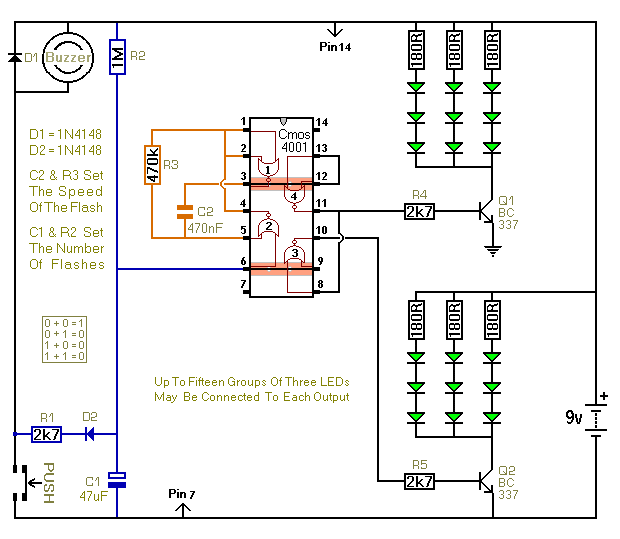The first circuit is described in complete detail. The remaining two circuits are only slightly different from the first - and their descriptions deal only with those differences. Therefore - to understand how the later circuits work - you should begin with Doorbell No.1
Doorbell Circuit No.2
The last circuit will flash up to two groups of 3 LEDs in tandem. This circuit will flash the two groups alternately. The alternate flashing creates the illusion of movement - and makes the display more eye-catching. Note that - although I've drawn the two groups of LEDs side by side - the individual LEDs can be mounted in any pattern you like
Doorbell Circuit No.3
The main difference between this circuit and the last one - is the addition of the two transistor switches. The switches will each flash up to 15 groups of 3 LEDs. And - because they are getting power directly from the battery - the LEDs will glow at their full brilliance.
Changing The Supply Voltage
I've drawn the circuits with a 9-volt supply. However - they can be adapted to a 6-volt or a 12-volt supply. This may involve changing the number of LEDs in the groups - and the value of Rx will need to be re-calculated. The following example is for Circuit No.3.
The LEDs have a forward voltage drop of about 2v each. With the 9-volt supply and three LEDs - you have 6-volts across the LEDs and 3-volts across the resistor. The current flowing through the three LEDs is the same as the current flowing through the resistor. And the current flowing through the resistor is V ÷ R. That is: -
3v ÷ 180Ω = 17mA.
With the 6-volt supply you should use groups of two LEDs. Then there's a total of 4-volts across the LEDs and 2-volts across the resistor. Change the value of the resistor to 120 ohms - and the current flowing through the two LEDs is: -
2v ÷ 120Ω = 17mA.
With the 12-volt supply you can use groups of five LEDs. Then there's a total of 10-volts across the LEDs and 2-volts across the resistor. Again - with a 120 ohm resistor - the current flowing through the five LEDs is: -
2v ÷ 120Ω = 17mA.
 SUGGESTIONS
SUGGESTIONS
 SUGGESTIONS
SUGGESTIONS


